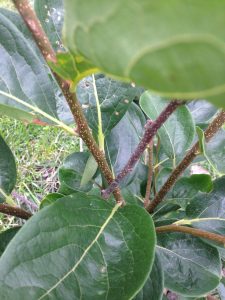
I’m in Toronto and planted a persimmon 3 years ago. The main stem was broken twice and now it’s bushy. How should I prune it? More importantly, what are the orange spots? 2 3″ new shoots are the only wood without them.
You appear to have the common or American persimmon, Diospyros virginiana, which is hardy in Toronto’s climate. It is not uncommon for the bark of many tree species – and especially immature specimens – to be speckled or stippled. The mature persimmon’s bark will ultimately be a uniquely square-blocked, ridged formation that is quite distinctive. You could take a closer look at the older branches and the trunk of your tree to see the mature bark developing. Here is a photograph of a young persimmon which exhibits the kind of bark markings you describe. The common persimmon is considered to be relatively free of harmful pests and diseases.
Pruning a persimmon tree which has lost its main stem or leader will be more a matter of corrective pruning and shaping. With some tree species, it is possible to train an alternative leader, i.e., another upright growing stem which could take the place of the original leader. From your description, your persimmon seems likely to retain its bushy shape. You can still tidy your tree to improve its structure by making sure that broken, dead or crossing branches are removed, down to the main stem. All other branches may be trimmed by no more than one-third, making sure you trim down to a leaf bud that is facing outward in the direction you would like the tree to grow (this will help you achieve an open, oval shape) and checking for shapeliness and balance as you go along. The best time to prune is late winter or early spring, when the tree is dormant. Here is a basic guide to pruning fruiting trees from the Ontario Ministry of Agriculture. If you feel that this kind of pruning is something you would prefer to leave to the experts, you could certainly call upon an arborist for this work.
If you would like to do some further reading, here are a few resources:

